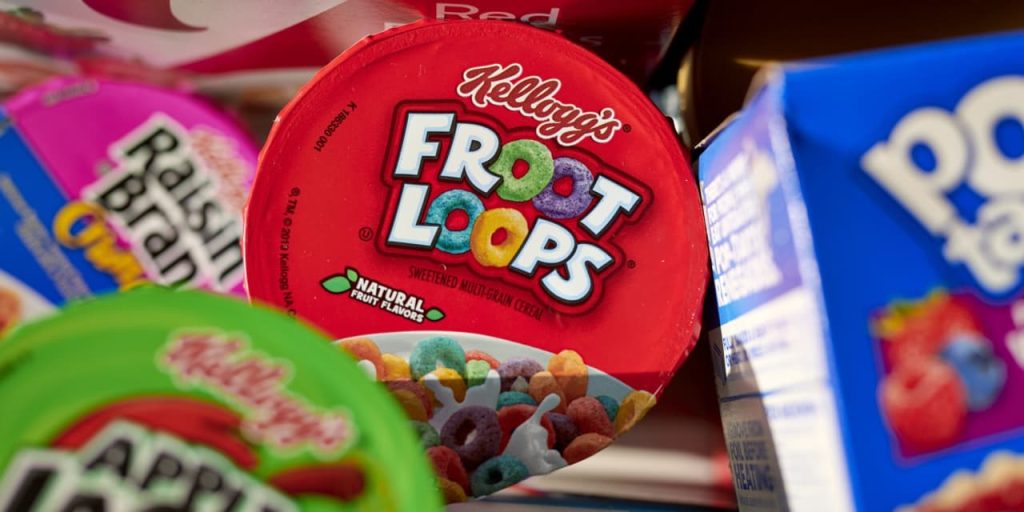Tony the Tiger is in the bargain bin.
WK
Kellogg
(ticker: KLG), the recent cereal spinoff from Kellogg, has had a tough debut. It has fallen more about 25% to below $10 a share from $13.35 on its first day of trading on Oct. 2. Shares fell 8.2% Monday to $9.90.
The stock may be the cheapest in the food sector. It is valued at less than seven times projected earning of about $1.50 a share in both 2023 and 2024.
WK Kellogg’s
dividend yield, which hasn’t been set yet, could top 6% based on the company’s guidance of a 45% payout ratio of 2024 earnings. WK Kellogg has a market value of less than $900 million and about $500 million of debt.
It is possible that the company could be swallowed up by a larger food company in the coming years given its very digestible market value and a leading position in the cereal industry.
The company is valued at about five times projected 2024 earnings before interest, taxes, depreciation and amortization (Ebitda). The Kellogg price/earnings and enterprise value/Ebitda ratios are about half the industry average.
WK Kellogg was created when Kellogg earlier this month separated its heritage cereal business to focus on its much larger snack-food business including Pringles, Pop Tarts and Cheez-It, which was renamed Kellanova (K) and retained the K ticker symbol. Kellogg holders got one share of WK Kellogg for every four Kellogg shares.
The Battle Creek, Mich.- based WK Kellogg appears to be a classic unloved spinoff that is being depressed by sales from Kellanova holders who don’t want exposure to the slow growth cereal business.
That could offer an opportunity for investors with the stock trading for about half of the fair value assigned by JP Morgan analyst Ken Goldman in August after a presentation on the spinoff by Kellogg.
WK Kellogg CEO Gary Pilnick talked up the oft-discussed benefits of a spinoff in a CNBC interview immediately after the spinoff, saying that the company would have better focus and a sales force entirely dedicated to cereal.
He called cereal “a terrific category” and said the centerpiece of the company’s strategy is to spend $450 million to $500 million—mostly in 2024 and 2025—to improve its supply chain and manufacturing capabilities in a program designed to roughly double its now anemic profit margins.
“This will not be easy but we have the strategy to go after it,” Pilnock said. The company declined to comment to Barron’s. It likely will have more to say on its outlook when it reports third-quarter earnings on Nov. 8.
Kellogg originated the category in the early 20th century but cereal sales have been in a slow decline for most of the past decade as breakfast tastes have shifted to foods like yogurt and breakfast bars.
With $2.7 billion of annual sales, WK Kellogg has a nearly 30% share in the U.S, No. 2 domestically behind
General Mills
(GIS). Top brands are Frosted Flakes, Froot Loops and Frosted Mini Wheats. Others include Special K, Rice Krispies and Corn Flakes as well as Kashi.
Besides the U.S., Kellogg operates in Canada and the Caribbean.
“Following the separation, WK Kellogg benefits from greater operational focus, fit-for-purpose strategy, and resource allocation,” wrote Spinoff Research’s Joe Cornell in a client note. He rates the stock a Hold but his price target of $14.50 is more than 40% above the current price.
Wall Street is lukewarm on WK Kellogg despite the low valuation with only one Buy among seven analysts tracked by Bloomberg.
Why? A tough category, low margins and a big investment spending program whose benefits may not be fully realized until 2026. Debt is likely to rise in the next two years as free cash flow is used for the dividend.
“New CEO Gary Pilnick—-who came across to us as energetic and knowledgeable, though of course a bit inexperienced as a CEO—does not expect sales to grow until 2027 at the earliest,” wrote Ken Goldman after Kellogg’s presentation in August. Pilnick was chief legal officer of Kellogg before the spinoff.
“W. K. Kellogg’s strategy is riskier than we anticipated. When the spin was first announced, most investors we spoke with assumed that WKK would be considered as more a cash cow than a major turnaround. A solid free cash flow generator like this, the thinking went, could provide nice shareholder returns via share repo and dividends,” Goldman wrote.
A lot of concern is now reflected in Kellogg’s very depressed stock. Cereal isn’t going away, and Kellogg offers a cheap play on its durability.
Corrections & Amplifications: Kellogg investors received one share of WK Kellogg, the cereal spinoff, for every four shares of Kellogg. An earlier version of this article incorrectly said Kellogg holders got one share of WK Kellogg for each Kellogg share.
Write to Andrew Bary at [email protected]
Read the full article here
